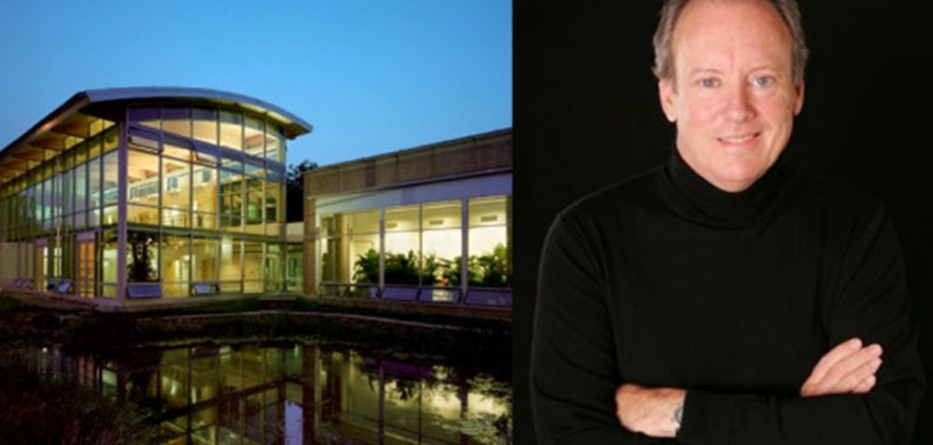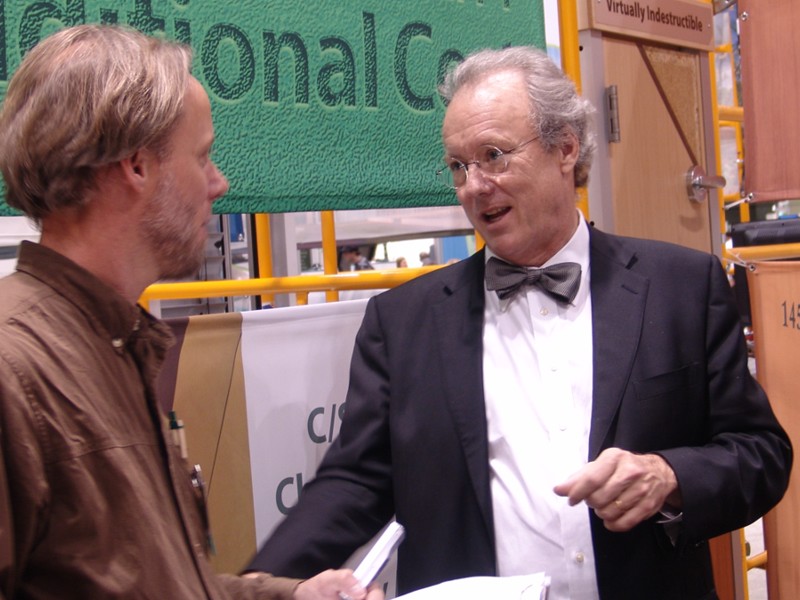Green architect and co-author of the pivotal green design handbook Cradle to Cradle, William McDonough is one of the founders of the green design movement and one of the preeminent thought-leaders of our time. His approach to sustainable design spans the entire industry – from large-scale projects (like designing the largest and most ambitious green roof in the world) to developing the most rigorous green product standard available. We recently had the opportunity to speak with Bill at the GreenBuild Conference about his work and the future of green design. We were joined by Howard Williams, VP of Construction Specialties, a leading proponent of safe materials in products, who introduced the company’s latest Cradle to Cradle-certified products. The thought-provoking and energetic conversation gave us a taste of how intimately intertwined design is with a product’s real-world impact – read on for our exclusive interview!
INHABITAT: What inspired you to write ‘Cradle to Cradle‘ (the book) and launch the Cradle to Cradle system?
William McDonough: From an early age, I was fascinated by differing attitudes towards resources. Growing up in Japan and Hong Kong, I was given my first look at complete material cycles, where waste becomes food, and resources like water are limited and precious. This contrasted greatly with the wastefulness I witnessed when my family moved to the United States, and that difference in attitude left a great impression on me. As a young architect, my thinking continued to evolve. I incorporated elements like solar energy into my designs and began to look closely at the sourcing of materials, but Cradle to Cradle really came to fruition when I met Dr. Michael Braungart. Together we developed the Cradle to Cradle philosophy, which we articulated in Cradle to Cradle: Remaking the Way We Make Things, which came out in 2002.
INHABITAT: Can you explain how the Cradle to Cradle rating system works – both from the perspective of manufacturers and consumers?
William McDonough: Cradle to Cradle products Certification goes beyond the definition of a rating system or a binary pass/fail seal of approval. Cradle to Cradle is a process for managing the total quality of a product and an engine for business innovation, taking into consideration not only environmental impact but also safety, health and social responsibility. The certification is a continuous and rigorous process, and participating companies hope to move their Basic products toward the achievement of Gold, Silver or Platinum. No single company product has yet achieved Platinum.
Certification takes into account five dimensions: materials as nutrients for safe continuous cycling; development of systems to safely close the loop on our biological and technical nutrients; power all operations with 100% renewable energy; regard water as a precious resource; and finally respect for all people and natural systems.
The iconic Eames Chair, now Cradle to Cradle Certified and sold through Herman Miller
INHABITAT: I was just talking with Paul Murray at Herman Miller about your contribution to their products and it was really extraordinary how closely related their company’s success is with your input. Was this the first company that you’ve worked with on such an intimate level? What helped shift the ethos of the company’s design culture?
William McDonough: We began to work with them when they stopped producing the Eames chairs out of rosewood – an endangered species. Ultimately, you really don’t want to mess with the icon of a company, but Herman Miller had a person working there who was so passionate about these issues that the company as a whole went ahead and changed the specs to walnut and stopped using endangered wood. It was a really nice thing for them to do.
But really what we’re dealing with here is product quality, and as a result a lot of these attributes you see highlighted by companies are various components that are focused on issues such as carbon reduction, and the like – single attributes. You also see a lot of claims to efficiency, which follows the train of thought “we’re less bad because we’ve reduced our badness by 20 percent.” We don’t want to be selling what we’re not. See, if I look at this sign with the word NO you realize that you’re selling what you’re not.
INHABITAT: In your book Cradle to Cradle, you make the point that when we recycled paper – we are giving up the original quality of the paper – we are losing something. Is most recycling just ‘downcycling’? Do we lose quality with every cycle of recycle?
William McDonough: Right, what we want again is product quality, and so with a company like Herman Miller there is an issue of quality. It’s similar to what we are seeing withConstruction Specialties here at GreenBuild – it’s about quality products in a fine system. From the market’s perspective you have to start to say things like this because they highlight that there are things to worry about, and that there are people who are genuinely interested and concerned about these things.
In Cradle to Cradle we addressed something that people may not understand when we proposed a form of producer responsibility over their product. The things we don’t talk about is a “life cycle”, so we don’t think that this material is alive. It’s not. We don’t see it as a consumer product because they can’t consume it. I can’t consume a TV, so we would call that a nutrient. We don’t talk about life cycle, we talk about use periods. We don’t talk about take back, we talk about reverse logistics or intelligent materials pooling. If something was removed from a building right, under our protocols, this is a safe thing to remove. That’s stainless steel, and that’s this, and that’s that, and they are defined. So then you go back into a materials pool.
It’s like a Herman Miller chair that ends up in Mexico City fifteen years from now, if somebody throws it out the back and into the dumpster. Well, the scavengers will just come and grab it. It’s worth something. The reason it’s worth something is that’s steel, and that’s aluminum, and that’s polycarbonates, and that polyethylenes. It’s no longer a chair, it’s part of the materials intelligent pool. So the design is that aluminum can come off and go back to aluminum, the steel goes back to steel. They’re not monstrous hybrids that can’t be separated.
Source: http://inhabitat.com/inhabitat-interview-green-architect-cradle-to-cradle-founder-william-mcdonough/











